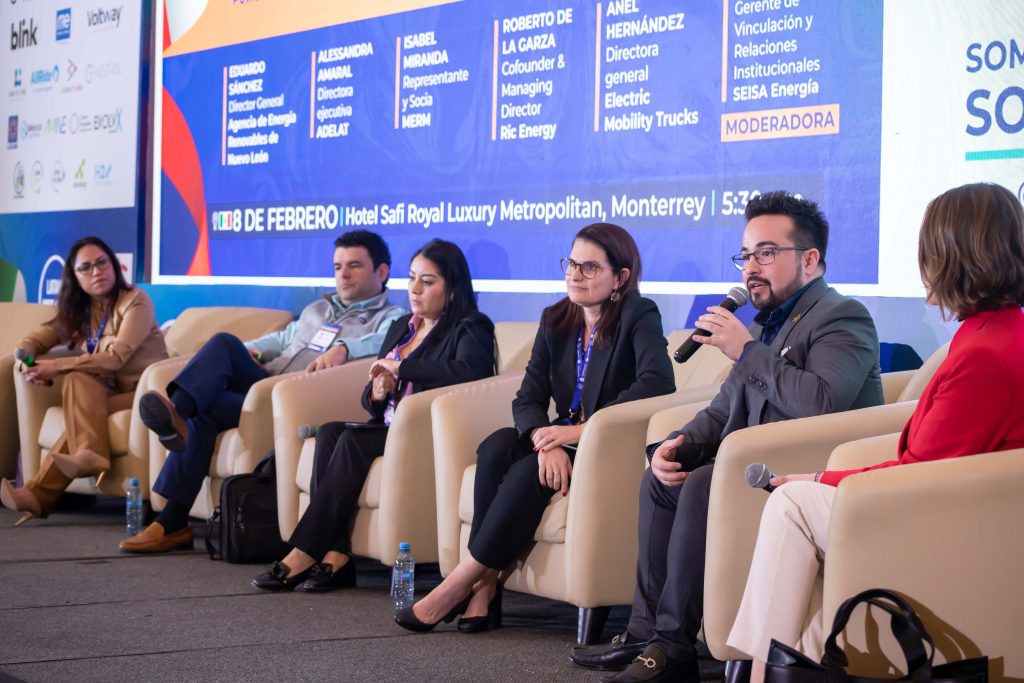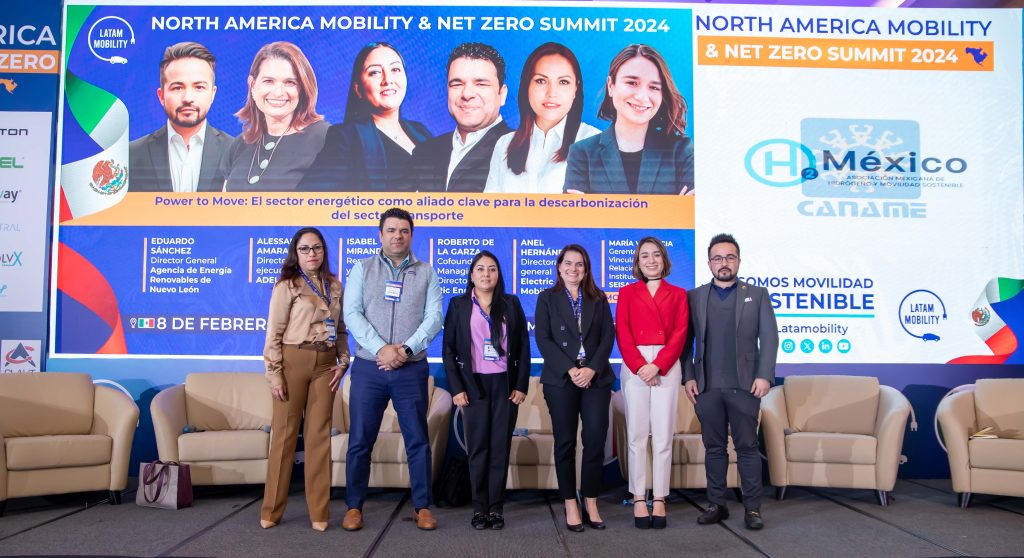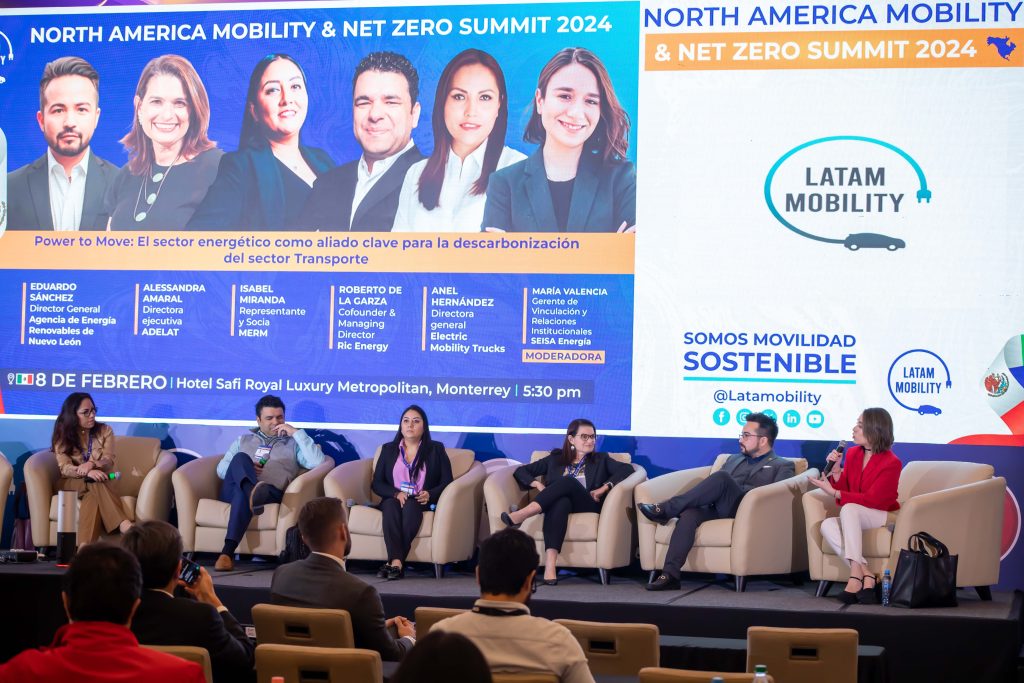The city of Monterrey, Mexico, marked the starting point of a series of face-to-face meetings organized by Latam Mobility, in the main countries of the continent, with the “North America Mobility & Net Zero Summit“, which brought together the most important companies and leaders linked to energy, transportation, fuels and mobility, to show the progress and prospects of the industry in Mexico, USA and the region.
The meeting featured a panel dedicated to the role of energy in the stabilization of sustainable transportation, entitled “Power to Move: The energy sector as a key ally for the decarbonization of transportation.”
The panel included the participation of Eduardo Sánchez, General Director of the Renewable Energy Agency of Nuevo León; Alessandra Amaral, Executive Director of the Association of Latin American Electric Energy Distributors (ADELAT); Roberto de la Garza, Co-Founder and General Director of Ric Energy; Isabel Miranda, Representative and Partner of Women in Renewable Energy Mexico (MERM), and Anel Hernández, General Director of Electric Mobility Trucks, under the moderation of María Valencia, Liaison and Institutional Relations Manager of SEISA Energía.
Value Chain Analysis
Eduardo Sánchez began by explaining that “the Renewable Energy Agency of Nuevo León has been in existence for a year, it seeks to take advantage of energy through renewable sources, and is working on the planning and structuring of an energy route that consists of four axes: Structuring our energy needs; optimizing demand; taking advantage of the generation potential, and the H230 program and sustainable mobility focused on infrastructure”.
Sanchez indicated that it is key to analyze the entire value chain. “There is no point in electrifying processes when the primary source of energy is not renewable. As an agency we seek to integrate sustainable mobility in the metropolitan area, and plan the points of greatest demand and congestion with generation solutions through renewables along with new energy vectors.
“To move forward there must be a regulatory framework, infrastructure and generation. In addition, these types of technologies or applications must be more affordable for the population, as well as more efficient at the storage level. On the other hand, local value chains must be integrated to enable vehicle development and economies of scale, with greater cost competitiveness, without forgetting tax incentives,” emphasized the representative of the Renewable Energy Agency of Nuevo Leon.

Leadership and Collaboration
Alessandra Amaral, Executive Director of ADELAT, explained that the objective of her organization is to stimulate leadership and collaboration among Latin American countries, focused on the distribution of electric power towards a just and sustainable transition. “We are currently made up of 19 members in seven countries: Brazil, Chile, Colombia, Argentina, Ecuador, Peru and Guatemala, with 70 million connections, 130 million people served and 300 terawatts of energy consumed.”
Regarding opportunities, Amaral indicated that electromobility is growing significantly in Latin America, driven by the supply of vehicles, the reduction of battery prices and greater concern about polluting gases. “We have three blocks of opportunities: the reduction of greenhouse gas emissions, the economic and social effect, and the substitution of the energy matrix.”
“The decarbonization of transportation is fundamental to the energy transition, which has seen an increase in its emissions, with higher rates since the 1970s. In a research conducted in 2022 together with Deloitte, showed that transportation impacts between 40% and 48% of greenhouse gases, depending on the country in Latin America. However, through new technologies, the reduction of emissions can reach up to 96%. A very significant number,” explained the ADELAT representative.
Multidisciplinary Work
For her part, Isabel Miranda, MERM‘s Representative, explained that the association is made up of a multidisciplinary team of women who work on sustainability and equity within the renewable energy sector. “We have advanced within the organization from renewable energies to sustainable mobility, within a context of product suppliers, energy solutions, utilities, among others.”
On the other hand, Miranda pointed out what he considers to be the opportunities of electromobility. “The first and most important of all is education, not only to multiply the message of the use of energy and mobility, but also to seek the growth of the number of people who can use electromobility.
In addition, the MERM representative pointed to the creation of charging infrastructure, the standardization of criteria, the creation of added value, new contributions and the creation of strategic alliances, as fundamental pieces to advance the transition towards a more sustainable mobility.
You may also be interested in: Yucatan Transportation Agency, Enel X, Metrorrey, Mobility ADO and NADB Pave the Way to Zero Emissions in Public Transport
Critical Infrastructure
Roberto de la Garza, Cofounder and Managing Director of Ric Energy, began by stating that the company was created eight years ago and has been evolving towards critical infrastructure. “We are currently developing eight electrical substations to industrial zones throughout the country; three last mile gas pipelines; and in relation to water, in Couhila we carry treated water with a capacity of 600 liters per second.”
“Ric Energy works in these three important areas of critical infrastructure, with 100% Mexican capital, but we had the opportunity to enter the area of electric gas stations since last year: we started the whole process and this year we will already have five distributed in Nuevo León and in the state of Coahuila,” added de la Garza.
In relation to the challenges, de la Garza considers that one of the most representative is the capacity of the electric infrastructure. “In the country’s industrial zones we have a critical problem. It is already difficult for companies to set up in a city because capacity is limited. We must be very cautious in how this energy transition is made, the transmission and distribution is readjusted. If there is no planning, and medium-sized cities are also included, we will not get anywhere”.

Break-even point
Anel Hernández, General Manager of Electric Mobility Trucks, distributor of the BYD brand in Mexico. “Our goal is to advance decarbonization, through synergies and alliances, which allow this migration from combustion to electric mobility to be simpler for the end customer, through support for companies seeking to advance the energy transition.”
“Currently, the electric vehicle is not affordable for everyone, but for the transportation sector, it is. We have conducted studies that show that in four years, if the units are mobilized around 30 km per year we will find the break-even point, taking into account infrastructure, cost reduction, and other factors, such as the incentives we have on electric units,” said Hernandez.
Finally, the representative of Electric Mobility Trucks indicated that customization in the transportation sector is an issue to be taken into account. “Each company may have very specific requirements for their electric units, such as refrigerated units for the food sector, which is not the same cooling that may require a unit of the pharmaceutical sector. Every need has to be taken into account to help with the transition.“
Below is the “2024 North America Mobility & Net Zero Summit”:



